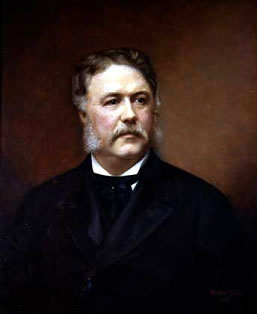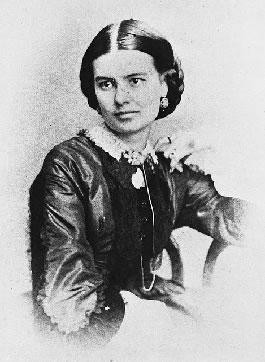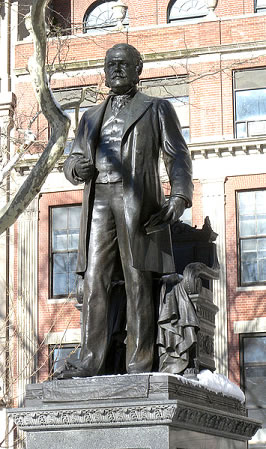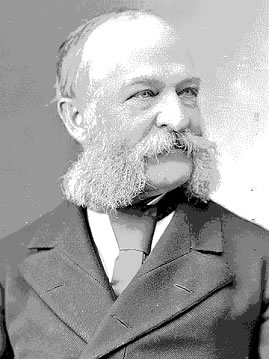The twenty-first president of the United States, Chester Alan Arthur (1830-1886) was reputed to be one of the leading spoilsmen in American politics when he took office, but he proved to be a dignified and an able administrator. Political enemies claimed that Chester A. Arthur was Canadian-born and therefore ineligible to be president of the United States. Arthur himself never replied to the charges and said that he was born on Oct. 5, 1830, in Fairfield, Vt., the eldest of seven children of a Scotch-Irish Baptist minister. He was educated at Union College in Schenectady, N.Y., taught school, and studied law. Moving to New York City, he built up a successful law practice and became interested in Republican party politics. Arthur rose steadily, if undramatically, in the Republican party by virtue of his willingness to perform the less exciting labors necessary to building a new political movement. New York City was slipping into the clutches of the Democratic party machine of William Marcy Tweed during the Civil War, but Arthur moved up steadily as the protégé of the state's governor. He served as engineer in chief, inspector general, and quartermaster general of New York, raising, equipping, and dispatching state troops for the Federal government. In 1863, when the Republicans were turned out of office, he stepped aside for a Democratic successor. By unanimous agreement he had been an excellent administrator. Arthur as a Spoilsman As a reward for his work for the party, in November 1871 President U.S. Grant named Arthur to be collector of customs for the Port of New York. In an>age when political parties functioned almost primarily for patronage - the jobs and other "spoils" which accrued to the party in power - Arthur possessed one of the most powerful and lucrative positions in the patronage apparatus by the time he was 41. As collector, he supervised more than 1000 employees, and many of these were troops in the New York State Republican machine. Arthur helped oversee the distribution of the jobs and, at election time, supervised the collection of "assessments" - contributions to Republican campaign funds which were virtually a requirement for holding a Federal job. The Customs House was no stranger to graft but Arthur himself was honest. He once said that "if I had misappropriated five cents, and on walking down-town saw two men talking on the street together, I would imagine they were talking of my dishonesty and the very thought would drive me mad." In a sense, corruption would have been superfluous. Arthur was paid by a fee of one-half of all monies he recovered for the government from importers misrepresenting what they owed. In one famous case Arthur and two other officials divided $135,000. His pay generally ran to $40,000 a year until 1874, when his salary was set at $12,000. Not all of this money stayed in Arthur's bank account. Like all political appointees, he was expected to make large donations to the party. These expenditures earned Arthur a prominent place in New York State's patronage-oriented Republican party. With Alonzo Cornell and Levi Morton, he stood second only to Roscoe Conkling in the control of New York's powerful political organization. His reputation among reformers was disgraceful but, until 1880, he could afford to ignore any pressures but Conkling's. Arthur's nicknames - "the Gentleman Boss," "the Elegant Arthur," - indicate the figure he cut. Over 6 feet tall, stoutly built according to the specifications of the times, with a wavy moustache and bushy sidewhiskers, he dressed in fine, fashionable clothing. He was exquisitely urbane, dining well, drinking the best wines and brandies, and entertaining on a grand scale. None of this was extraordinary in middle-class New York City, but it made for a stunning contrast to the conservatively clothed and morally straitlaced Midwestern Republican politicians among whom he moved in Washington. Accidental President In 1880 Republicans divided sharply and bitterly over the nomination of a presidential candidate. The two principal hopefuls were former president U.S. Grant (Conkling and Arthur were among his chief advocates) and James G. Blaine. The deadlocked convention resolved the issue only by turning to a dark-horse candidate, James A. Garfield of Ohio. Conkling, the leader of the pro-Grant faction, was furious - for Garfield was friendlier to Blaine than himself - and he insisted that Levi Morton decline the offered vice-presidential nomination. Arthur was the Garfield group's second vice-presidential choice and, though Conkling remained adamant, Arthur accepted. Arthur continued to pay court to Conkling, however, even after the election had made him vice president of the United States. In fact, Arthur was in Albany, lobbying for Conkling's reelection, when news arrived that President Garfield had been shot in Washington by a deranged man who claimed he did it in order to make Arthur president. Garfield died on Sept. 19, 1881, and Arthur became president. Historians tend to agree that Arthur was a much better president than anyone expected. He seemed sensitive to the dignity of his office, and, while he continued to send most patronage to his old allies, he generally extricated himself from their society. Though he offered Conkling a seat on the Supreme Court, he left one of Conkling's old enemies in the Customs House. Republicans on the side of reform were chagrined at this new president, but Arthur could be surprising. He even supported and signed a landmark civil service bill (providing, among other things, for examinations as a prerequisite to holding some government jobs), and he permitted an investigation of post office frauds, which implicated several cronies. Arthur remained what he had always been, a good administrator. But, as H. Wayne Morgan (1969) points out, "Arthur liked the appearance of power more than its substance." He designed a flag for himself, relished military ceremonies, refurbished the shabby White House, and presented a perfect presidential appearance. He took little initiative in the significant events of his term, such as the Pendleton Civil Service Act and the construction of a modern navy. Unfortunately for Arthur's political future (he would have liked to be reelected in 1884), he had alienated old supporters without winning over old enemies. In 1884 he had no real strength at the Republican Convention and was quietly shelved. He died in 1886. He had not inspired his contemporaries, and, though his biographers have been friendly, he has not inspired them either. |
 |
Chester Alan Arthur Born: October 5, 1829
|
|
 |
|
First lady: Ellen Arthur |
|
 |
|
| Chester A. Arthur statue at Madison Square in New York City | |
 |
|
| In an 1881 Puck cartoon, Arthur faces the presidential cabinet after President James A. Garfield was assassinated. |